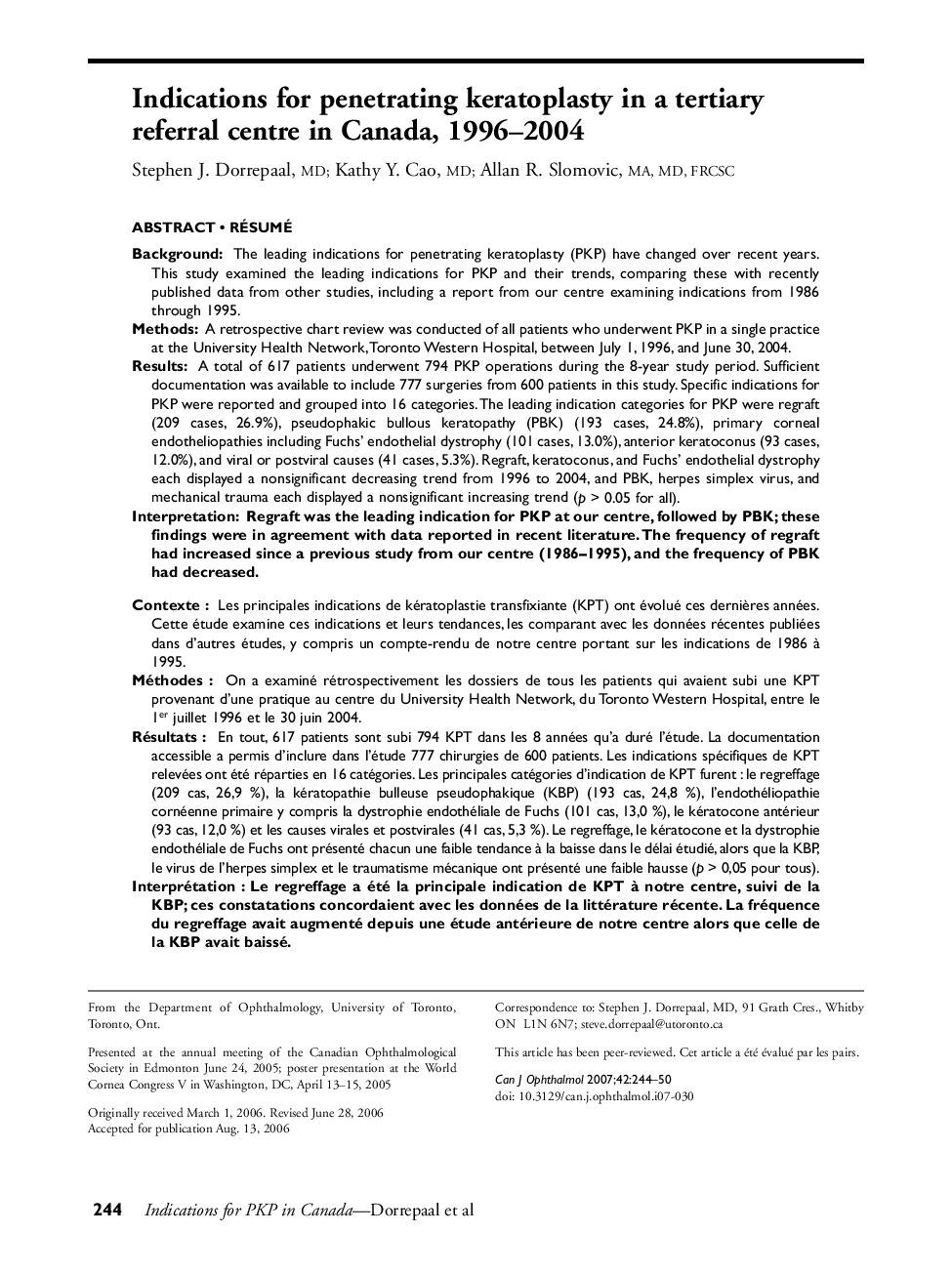| Article ID | Journal | Published Year | Pages | File Type |
|---|---|---|---|---|
| 4010753 | Canadian Journal of Ophthalmology / Journal Canadien d'Ophtalmologie | 2007 | 7 Pages |
Background: The leading indications for penetrating keratoplasty (PKP) have changed over recent years. This study examined the leading indications for PKP and their trends, comparing these with recently published data from other studies, including a report from our centre examining indications from 1986 through 1995.Methods: A retrospective chart review was conducted of all patients who underwent PKP in a single practice at the University Health Network,Toronto Western Hospital, between July 1, 1996, and June 30, 2004.Results: A total of 617 patients underwent 794 PKP operations during the 8-year study period. Sufficient documentation was available to include 777 surgeries from 600 patients in this study. Specific indications for PKP were reported and grouped into 16 categories.The leading indication categories for PKP were regraft (209 cases, 26.9%), pseudophakic bullous keratopathy (PBK) (193 cases, 24.8%), primary corneal endotheliopathies including Fuchs' endothelial dystrophy (101 cases, 13.0%), anterior keratoconus (93 cases, 12.0%), and viral or postviral causes (41 cases, 5.3%). Regraft, keratoconus, and Fuchs' endothelial dystrophy each displayed a nonsignificant decreasing trend from 1996 to 2004, and PBK, herpes simplex virus, and mechanical trauma each displayed a nonsignificant increasing trend (p > 0.05 for all).Interpretation: Regraft was the leading indication for PKP at our centre, followed by PBK; these findings were in agreement with data reported in recent literature.The frequency of regraft had increased since a previous study from our centre (1986–1995), and the frequency of PBK had decreased.
RésuméContexte: Les principales indications de kératoplastie transfixiante (KPT) ont évolué ces dernières années. Cette étude examine ces indications et leurs tendances, les comparant avec les données récentes publiées dans d’autres études, y compris un compte-rendu de notre centre portant sur les indications de 1986 à 1995.Méthodes: On a examiné rétrospectivement les dossiers de tous les patients qui avaient subi une KPT provenant d’une pratique au centre du University Health Network, du Toronto Western Hospital, entre le 1er juillet 1996 et le 30 juin 2004.Résultats: En tout, 617 patients sont subi 794 KPT dans les 8 années qu’a duré l’étude. La documentation accessible a permis d’inclure dans l’étude 777 chirurgies de 600 patients. Les indications spécifiques de KPT relevées ont été réparties en 16 catégories. Les principales catégories d’indication de KPT furent: le regreffage (209 cas, 26,9 %), la kératopathie bulleuse pseudophakique (KBP) (193 cas, 24,8 %), l’endothéliopathie cornéenne primaire y compris la dystrophie endothéliale de Fuchs (101 cas, 13,0 %), le kératocone antérieur (93 cas, 12,0 %) et les causes virales et postvirales (41 cas, 5,3 %). Le regreffage, le kératocone et la dystrophie endothéliale de Fuchs ont présenté chacun une faible tendance à la baisse dans le délai étudié, alors que la KBP, le virus de l’herpes simplex et le traumatisme mécanique ont présenté une faible hausse (p > 0,05 pour tous).Interprétation: Le regreffage a été la principale indication de KPT à notre centre, suivi de la KBP; ces constatations concordaient avec les données de la littérature récente. La fréquence du regreffage avait augmenté depuis une étude antérieure de notre centre alors que celle de la KBP avait baissé.
